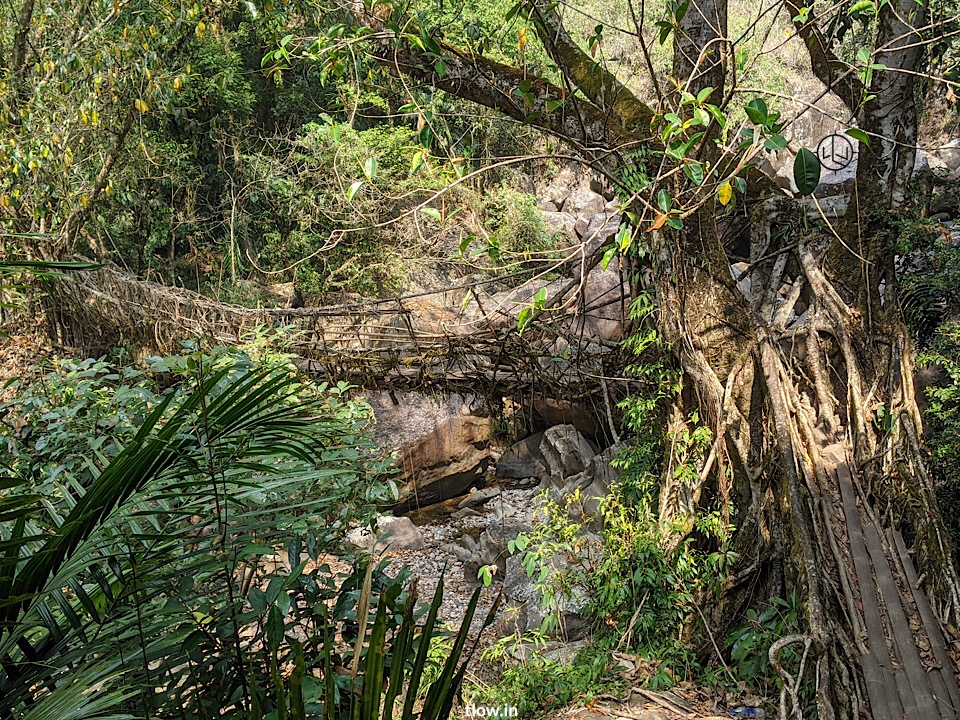
Splendor of Meghalaya’s double-decker root bridge
The miraculous double-decker root bridge is the best combination of nature and human engineering. Deep in the dense tropical forest of Meghalaya, and shrouded in cloud and rain for much of the year, they are some of the most astonishing man-made natural wonders. Known as the living root bridges, inventive members of the Khasi tribe have trained them to grow from the roots of ancient rubber trees, native to the northeast region.
The root bridges provide a stable alternative to wooden bridges, which decay and get destroyed during the lengthy monsoon seasons. Even the logs get broken during heavy rainfall in the area. So Khasis have made a permanent solution for this.
It takes around 15 years for a new root bridge to become strong enough to bear the weight of people crossing it. However, it will continue to grow and strengthen even more over time. Some of the bridges are believed to be hundreds of years old, although no one knows their exact age. Their tangled webs of roots are almost eerie in nature and wouldn't look out of place in a fantasy world.
The renowned double-decker root bridge near Cherrapunji, in Northeast India's Meghalaya state, beckons outdoor enthusiasts with the opportunity to see a 150+-year-old man-made natural wonder that's not only unique but astounding. While there are a number of single root bridges in the area, this is the only one that has two levels.
Apparently, local Khasi tribe members grew the second level after an unprecedented wet monsoon season caused water to reach the first level. A third level is planned, but only to capitalize on the bridge's tourism potential.
Visiting the double-decker root bridge is not easy. The trek there is long and tiring. It's worth it though, for an out-of-this-world experience that's guaranteed to be the highlight of your travels.
The double-decker root bridge is situated near the Nongriat village where you can only go if you trek. The trek starts from Tyrna village which is on the hilltop where the vehicles come from Sohra. From Sohra to Tyrna, it is a 12 kms drive over the slopes and curves of the Khasi hills. One can opt for a taxi from Sohra or private vehicles are also available. It takes 30 to 45 minutes to reach the starting point of the trek from Tyrna village.
Food stalls are available where you get Maggi and omelette. It is advisable to get a stick for support while trekking. You get it for 20 bucks from any point. Have sufficient water with you and even if you don't have, you can buy it while getting down the stairs.
The trek takes 2 hours minimum to reach Nongriat. It all depends on person to person, how much time they wanna spend while trekking. Also, keep in mind the place gets dark by 5 pm. So better finish the trek in daylight.
The trek to Nongriat village is of 3500 steps from one side. It needs a lot of physical endurance and determination, but the trek is worth going to the end. Pack light, so that your shoulders don't pain. The trek starts with Tyrna village where one could witness the local life of the Khasi tribal community. The whole area is filled with flowers and plants. The interesting part is that they have kept a nameplate with the tree's biological name, so you know what species you are seeing.
When you go further, you will see the sitting arrangement made by the locals to enjoy the view of the valley. One can sit in peace and admire the view of the valley.
The stairs get deeper when you go down the hills, be careful with the stairs. It is advisable to have a good grip and lightweight shoes to do this trek. Both sides are covered with various trees and all you can hear is the sound of nature which makes you calm and composed. After scouting through the forest, you will see this amazing suspension bridge over the Sindhem river and waterfall.
When you head on next, you will get a small single root bridge which connects you to the village of Nongriat. There are signboards available everywhere which directs you to the double-decker bridge. The minimal cost of ₹30 is an entry fee for the maintenance of the bridge and the surroundings.
A peaceful spot to go to is the opposite side of the bridge where you can see a waterfall and pond. You dip your feet in the water and get natural fish therapy. Enjoy nature as long as you want.
Bonus information:
You can even head to secret waterfalls deep inside the forest and enjoy the surrounding by yourself. Word of caution is to take a local guide with you because they know in which direction to head inside the forest.
-->For a similar experience, >>Click here
-->To plan a trip to Asia, >>Click here
-->For a similar experience, >>Click here
-->To plan a trip to North-East India, >>Click here
-->For a similar experience, >>Click here
-->To plan a trip to Himachal Pradesh, >>Click here











